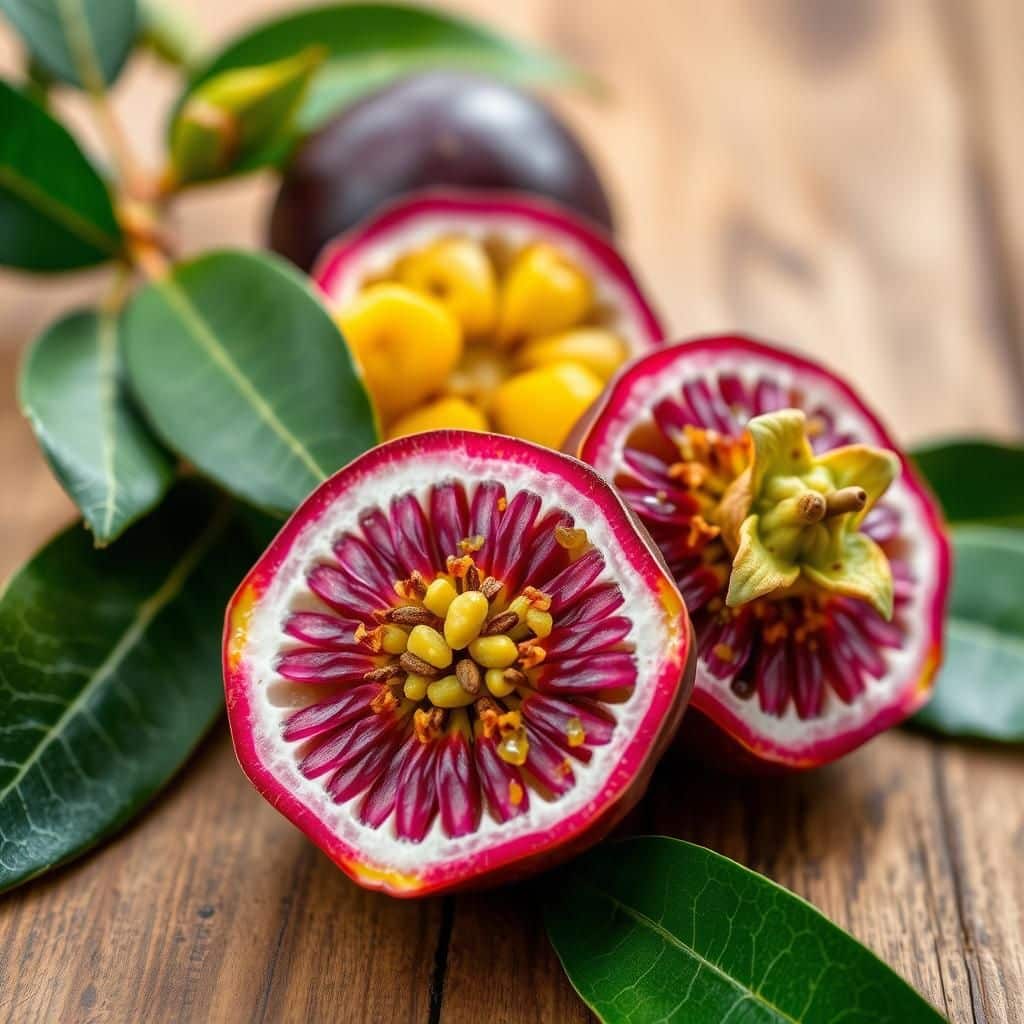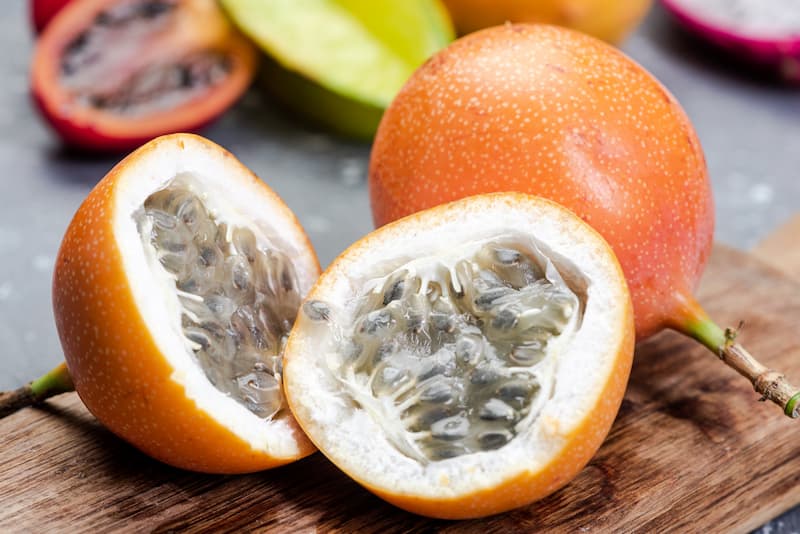Unlocking the Wonders of Passion Fruit Sweet Granadilla: A Delicious Guide to Flavor and Use

Passion fruit, scientifically known as Passiflora edulis, is a tropical delight that captivates with its vibrant flavor and unique aroma. Often referred to as sweet granadilla, this exotic fruit is not only a feast for the senses but also a versatile ingredient in various culinary creations. From refreshing beverages to decadent desserts, passion fruit elevates dishes with its tangy sweetness and distinctive texture. In this guide, we will explore the wonders of sweet granadilla, uncovering its flavor profile, health benefits, and innovative ways to incorporate it into your cooking. Discover how to make the most of this enticing fruit!
Understanding the Sweet Delight of Passion Fruit (Sweet Granadilla)
Passion fruit, commonly referred to as sweet granadilla, is a tropical fruit known for its vibrant exterior and rich, aromatic flavor. This fruit is a member of the Passifloraceae family and is celebrated not only for its delicious taste but also for its numerous health benefits. The sweet granadilla's flesh is filled with small, edible seeds encased in a gelatinous, yellow-orange pulp, creating a delightful texture and a unique taste that ranges from sweet to slightly tart. It is often enjoyed fresh, added to desserts, smoothies, or cocktails, and is rich in vitamins A and C, dietary fiber, and antioxidants, making it a nutritious option for those looking to enhance their diet.
Nutritional Benefits of Passion Fruit
Passion fruit is a powerhouse of nutritional benefits, offering a variety of vitamins and minerals essential for maintaining good health. It is particularly high in vitamin C, which boosts the immune system, and vitamin A, important for eye health. In addition, passion fruit provides dietary fiber, aiding in digestive health and promoting a feeling of fullness, which is beneficial for weight management. Its rich antioxidant content helps combat oxidative stress in the body, while the presence of beneficial plant compounds may support heart health and reduce inflammation.
Culinary Uses of Sweet Granadilla
The culinary possibilities with sweet granadilla are vast and versatile. This fruit can be enjoyed fresh, scooped straight from its shell, or used in a variety of dishes. Common uses include incorporating it into smoothies, desserts such as puddings and sorbets, and as a topping for yogurt and ice cream. It can also feature prominently in salads, providing a refreshing burst of flavor, or serve as a unique ingredient in cocktails. The sweet, tangy flavor of passion fruit pairs well with other fruits, making it a delightful addition to fruit salads and savory dishes alike.
Growing Passion Fruit: Tips and Techniques
Growing passion fruit can be a rewarding experience for home gardeners. The plant thrives in warm climates, requiring plenty of sunlight and well-drained soil. It can be grown from seeds or propagated from cuttings, with the ideal planting season being the spring after the last frost. Proper watering is essential, as the plants prefer evenly moist but not waterlogged soil. Additionally, providing a trellis or support structure is important, as passion fruit vines are vigorous climbers. With the right care, gardeners can enjoy a bountiful harvest of sweet granadilla in their backyards.
Harvesting and Storing Passion Fruit
Harvesting passion fruit is a simple process, as the fruit is typically ready to pick when it has reached its full color and starts to wrinkle slightly on the skin. This indicates that it has reached optimal ripeness and flavor. To store passion fruit, keep it in a cool, dry place for a few days or refrigerate it to prolong its shelf life. Wrinkled fruit is still good to eat, as the flavor intensifies with age. Once cut, the pulp can be stored in the refrigerator for a few days, making it convenient for use in recipes over time.
Passion Fruit Varieties and Their Characteristics
There are several varieties of passion fruit, each with distinct characteristics. Among the most commonly known are the yellow and purple varieties. The yellow passion fruit is generally larger and has a slightly tart flavor, making it popular for juicing. On the other hand, the purple variety is sweeter and smaller, often consumed whole or used in desserts. Another variety, the sweet granadilla, is known for its soft shell and mild sweetness, making it a favorite among those who enjoy its delicate flavor. Understanding these differences can help consumers choose the right type for their culinary needs.
| Fruit Variety | Flavor Profile | Best Uses |
|---|---|---|
| Yellow Passion Fruit | Tart | Juicing, sauces |
| Purple Passion Fruit | Sweet | Fresh eating, desserts |
| Sweet Granadilla | Mildly sweet | Fresh eating, salads |
Is sweet granadilla edible?

Yes, sweet granadilla is indeed edible. This fruit, scientifically known as Passiflora ligularis, belongs to the Passifloraceae family and is often enjoyed for its sweet and aromatic flavor. Sweet granadilla is typically round to oval in shape, with a smooth yellow or orange rind. Inside, it contains juicy, gelatinous seeds surrounded by a sweet pulp that is both pleasing to the palate and nutritious. Many people consume sweet granadilla fresh, while others use it in recipes for desserts, smoothies, or salads. It is not only delicious but also packed with vitamins and antioxidants, making it a healthy choice as well.
The Nutritional Benefits of Sweet Granadilla
Sweet granadilla offers a variety of nutritional benefits that make it a worthwhile addition to one's diet. It is rich in vitamins A and C, which are essential for maintaining healthy skin and immune function. Additionally, the fruit contains dietary fiber, which aids in digestion and helps maintain a healthy weight. Here are some key benefits:
- Rich in Vitamins: Provides essential nutrients like vitamin A and C.
- High in Fiber: Supports digestive health and can help with weight management.
- Antioxidant Properties: Contains antioxidants that combat oxidative stress in the body.
How to Prepare Sweet Granadilla
Preparing sweet granadilla is quite simple and requires minimal effort. To enjoy this fruit, one must first select a ripe granadilla, which will have a slightly wrinkled skin. Then, it can be cut in half to reveal the juicy pulp and seeds. The pulp can be scooped out with a spoon and eaten directly or added to various dishes. Here’s a quick guide:
See also:
- Selecting Ripe Fruit: Look for slightly wrinkled skin, indicating ripeness.
- Cutting the Fruit: Slice it in half to access the edible pulp.
- Serving: Enjoy the pulp raw or incorporate it into recipes.
Common Uses of Sweet Granadilla in Cooking
Sweet granadilla is versatile and can be used in numerous culinary applications. Its vibrant flavor pairs well with different ingredients, making it suitable for both sweet and savory dishes. Here are some popular ways to use sweet granadilla in cooking:
- In Smoothies: Blending it into smoothies for added sweetness and nutrition.
- As a Topping: Using the pulp as a topping for desserts like ice cream or yogurt.
- In Salads: Mixing it into fruit salads for a tropical twist.
Potential Health Benefits of Consuming Sweet Granadilla
In addition to its nutritional content, sweet granadilla may offer various health benefits. Regular consumption of this fruit can support overall well-being and may help with specific health issues. Here are some potential benefits:
- Improved Digestion: High fiber content aids in better digestive health.
- Boosted Immunity: Vitamin C enhances the immune system's function.
- Heart Health: Antioxidants support cardiovascular health by reducing inflammation.
Where to Buy Sweet Granadilla
Sweet granadilla can often be found in grocery stores, farmers' markets, and specialty fruit shops. Availability may vary depending on the season and location. It is important to look for fresh, ripe fruits to ensure the best flavor and quality. Here’s where you can typically find it:
- Local Grocery Stores: Check the produce section for fresh fruits.
- Farmers' Markets: Purchase directly from local growers for fresher options.
- Online Retailers: Explore online grocery delivery services for convenience.
Is granadilla the same as pomegranate?

No, granadilla is not the same as pomegranate. These two fruits are distinct in terms of their botanical classifications, physical characteristics, flavors, and uses.
Granadilla, scientifically known as Passiflora ligularis, is a member of the passionflower family and is known for its sweet and aromatic flavor. It typically has a yellow-orange skin when ripe, and its interior is filled with juicy pulp and numerous black seeds. On the other hand, pomegranate, which is scientifically known as Punica granatum, belongs to the family Lythraceae and is recognized for its tough, reddish skin containing numerous jewel-like seeds called arils.
Botanical Classification
Granadilla and pomegranate are classified under different families and genera.
- Granadilla is part of the Passifloraceae family.
- Pomegranate belongs to the Lythraceae family.
- Granadilla is in the genus Passiflora, while pomegranate is in the genus Punica.
Physical Characteristics
The physical attributes of granadilla and pomegranate are quite different.
- Granadilla features a smooth, yellow-orange outer skin.
- Pomegranate has a tough, leathery, reddish-brown exterior.
- The interior of granadilla consists of juicy pulp, whereas pomegranate contains many seeds encased in sweet or tart arils.
Flavor Profile
The taste of both fruits varies significantly.
- Granadilla has a sweet and tropical flavor profile.
- Pomegranate can range from sweet to tart, depending on the variety.
- The flavor of granadilla is often described as more delicate compared to the bold taste of pomegranate.
Culinary Uses
Granadilla and pomegranate are used differently in various cuisines.
- Granadilla is commonly eaten fresh or made into desserts and smoothies.
- Pomegranate is widely used in salads, juices, sauces, and as a garnish.
- The seeds of pomegranate are often extracted and used to add texture and flavor to dishes.
Nutritional Content
Both fruits offer different nutritional benefits.
See also:
- Granadilla is high in antioxidants, vitamins A and C.
- Pomegranate is also rich in antioxidants, particularly punicalagins, which are highly beneficial for health.
- Both fruits provide dietary fiber, but their vitamin content varies.
What does a granadilla taste like?

Granadilla, a tropical fruit related to passion fruit, offers a unique flavor profile that is often described as a blend of sweet and tart. The taste of granadilla is typically characterized by its juicy inner pulp, which is filled with tiny seeds surrounded by a gelatinous texture. When you take a bite, you will encounter a combination of sweetness with a hint of citrus acidity that can vary in intensity depending on the ripeness of the fruit.
The outer shell of the granadilla is hard and smooth, usually orange or yellow in color. Once you break it open, the vibrant, aromatic pulp reveals itself, inviting you to savor its complex flavors. The overall experience is refreshing, making it a delightful addition to smoothies, desserts, or even eaten on its own.
The Flavor Profile of Granadilla
The flavor profile of granadilla can be best described as a medley of sensations. Its taste balances both fruitiness and acidity, which can be broken down into the following components:
- Sweetness: The predominant flavor is sweet, reminiscent of ripe mango or peach.
- Tartness: There is also a slight tartness that adds complexity, similar to kiwi or citrus fruits.
- Aromatic notes: The fragrance and aftertaste can evoke impressions of tropical flowers, enhancing the overall experience.
Textural Experience of Eating Granadilla
The texture of granadilla contributes significantly to its appeal. When you eat it, you will notice various textures that change as you savor it:
- Juicy pulp: The pulp is incredibly juicy, bursting with flavor as you bite into it.
- Crunchy seeds: The tiny seeds add a delightful crunch, contrasting the softness of the pulp.
- Gelatinous consistency: The gelatinous surrounding of the pulp gives a unique mouthfeel, which is both interesting and refreshing.
Culinary Uses of Granadilla
Granadilla is versatile in the culinary world and can be utilized in various dishes. Here are some common uses:
- Smoothies: The sweet flavor complements other fruits, making it a popular ingredient.
- Desserts: Granadilla can be used in tarts, cakes, or mousse for added flavor and decoration.
- Salads: Adding granadilla to salads provides a burst of tropical flavor that balances savory ingredients.
Health Benefits of Granadilla
Granadilla not only tastes good but also offers several health benefits that make it a great addition to your diet:
- Rich in vitamins: It is a good source of vitamin C, which boosts the immune system.
- High in fiber: The fruit is rich in dietary fiber, promoting healthy digestion.
- Low in calories: Granadilla is low in calories, making it a guilt-free snack option.
How to Choose and Store Granadilla
Choosing the right granadilla and storing it properly is essential for enjoying its flavor fully. Here are tips to consider:
- Look for ripeness: Choose fruit that is slightly soft to the touch, indicating ripeness.
- Avoid blemishes: Select fruits without any dark spots or cracks on the shell.
- Storage tips: Store in a cool, dry place, and refrigerate once ripe to prolong freshness.
Questions from Our Readers
What is passion fruit sweet granadilla?
Passion fruit sweet granadilla is a tropical fruit known for its sweet, juicy pulp and aromatic flavor. It belongs to the Passifloraceae family and is commonly found in warmer climates. The fruit is characterized by its smooth, bright orange skin and is often used in desserts, beverages, or enjoyed fresh.
How do you eat passion fruit sweet granadilla?
To eat passion fruit sweet granadilla, simply cut the fruit in half and scoop out the pulp with a spoon. The seeds are edible, and many people enjoy the crunchy texture they provide. You can add the pulp to yogurt, smoothies, or desserts, or simply eat it raw for its refreshing taste.
What are the health benefits of passion fruit sweet granadilla?
Passion fruit sweet granadilla is rich in vitamins A and C, as well as dietary fiber, making it a nutritious choice. The fruit is known for its antioxidant properties, which can help protect the body from free radicals. Additionally, it may aid in digestion and support a healthy immune system.
See also:
Where can you buy passion fruit sweet granadilla?
Passion fruit sweet granadilla can typically be found at local markets, grocery stores, or specialty organic shops that sell tropical fruits. Depending on the season, it might also be available at larger supermarkets or through various online retailers. Always look for fresh and ripe fruits for the best flavor.

If you want to read more articles like Unlocking the Wonders of Passion Fruit Sweet Granadilla: A Delicious Guide to Flavor and Use, we recommend you check out our Seeds category.
Leave a Reply
Related Articles